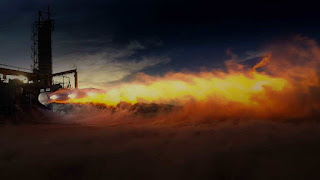Rocket engine uses stored rocket propellants as the reaction mass for forming a high-speed propulsive jet of fluid, usually high-temperature gas. Rocket engines are reaction engines, producing thrust by ejecting mass rearward, in accordance with Newton’s third law.
Rocket engines produce thrust by the expulsion of an exhaust fluid that has been accelerated to high speed through a propelling nozzle.
The fluid is usually a gas created by high pressure combustion of solid or liquid propellants, consisting of fuel and oxidiser components, within a combustion chamber. As the gases expand through the nozzle, they are accelerated to very high (supersonic) speed, and the reaction to this pushes the engine in the opposite direction.
Rocket technology can combine very high thrust (meganewtons), very high exhaust speeds (around 10 times the speed of sound in air at sea level) and very high thrust/weight ratios simultaneously as well as being able to operate outside the atmosphere, and while permitting the use of low pressure and hence lightweight tanks and structure.
Rockets can be further optimised to even more extreme performance along one or more of these axes at the expense of the others. ©Wallpaper Flare
©Wallpaper Flare
Most rocket engines use the combustion of reactive chemicals to supply the necessary energy.
Also thermal rockets exist, which use an inert propellant, heated by electricity or a nuclear reactor.
For efficiency reasons, higher temperatures are desirable, but materials lose their strength if the temperature becomes too high. Rockets run with combustion temperatures that can reach 3,500 K (3,200 °C; 5,800 °F).
Most other jet engines have gas turbines in the hot exhaust. Due to their larger surface area, they are harder to cool and hence there is a need to run the combustion processes at much lower temperatures, losing efficiency.
In addition, duct engines use air as an oxidant, which contains 78% largely unreactive nitrogen, which dilutes the reaction and lowers the temperatures. Rockets have none of these inherent combustion temperature limiters.
Rockets that use the common construction materials such as aluminium, steel, nickel or copper alloys must employ cooling systems to limit the temperatures that engine structures experience.
Regenerative cooling, where the propellant is passed through tubes around the combustion chamber or nozzle, and other techniques, such as curtain cooling or film cooling, are employed to give longer nozzle and chamber life.
Compared to other types of jet engine, rocket engines are the lightest and have the highest thrust, but are the least propellant-efficient.
Rocket engines become more efficient at high speeds, due to the Oberth effect.
Rocket engines are usually statically tested at a test facility before being put into production. For high altitude engines, either a shorter nozzle must be used, or the rocket must be tested in a large vacuum chamber.
Rocket engines produce thrust by the expulsion of an exhaust fluid that has been accelerated to high speed through a propelling nozzle.
The fluid is usually a gas created by high pressure combustion of solid or liquid propellants, consisting of fuel and oxidiser components, within a combustion chamber. As the gases expand through the nozzle, they are accelerated to very high (supersonic) speed, and the reaction to this pushes the engine in the opposite direction.
Rocket technology can combine very high thrust (meganewtons), very high exhaust speeds (around 10 times the speed of sound in air at sea level) and very high thrust/weight ratios simultaneously as well as being able to operate outside the atmosphere, and while permitting the use of low pressure and hence lightweight tanks and structure.
Rockets can be further optimised to even more extreme performance along one or more of these axes at the expense of the others.
 ©Wallpaper Flare
©Wallpaper FlareMost rocket engines use the combustion of reactive chemicals to supply the necessary energy.
- Solid-fuel use propellant in a solid phase.
- Liquid-propellant use one or more propellants in a liquid state fed from tanks.
- Hybrid use a solid propellant in the combustion chamber, to which a second liquid or gas oxidizer or propellant is added to permit combustion.
- Monopropellant use a single propellant decomposed by a catalyst. The most common monopropellants are hydrazine and hydrogen peroxide.
Also thermal rockets exist, which use an inert propellant, heated by electricity or a nuclear reactor.
For efficiency reasons, higher temperatures are desirable, but materials lose their strength if the temperature becomes too high. Rockets run with combustion temperatures that can reach 3,500 K (3,200 °C; 5,800 °F).
Most other jet engines have gas turbines in the hot exhaust. Due to their larger surface area, they are harder to cool and hence there is a need to run the combustion processes at much lower temperatures, losing efficiency.
In addition, duct engines use air as an oxidant, which contains 78% largely unreactive nitrogen, which dilutes the reaction and lowers the temperatures. Rockets have none of these inherent combustion temperature limiters.
Rockets that use the common construction materials such as aluminium, steel, nickel or copper alloys must employ cooling systems to limit the temperatures that engine structures experience.
Regenerative cooling, where the propellant is passed through tubes around the combustion chamber or nozzle, and other techniques, such as curtain cooling or film cooling, are employed to give longer nozzle and chamber life.
Compared to other types of jet engine, rocket engines are the lightest and have the highest thrust, but are the least propellant-efficient.
Rocket engines become more efficient at high speeds, due to the Oberth effect.
Rocket engines are usually statically tested at a test facility before being put into production. For high altitude engines, either a shorter nozzle must be used, or the rocket must be tested in a large vacuum chamber.


Post a Comment